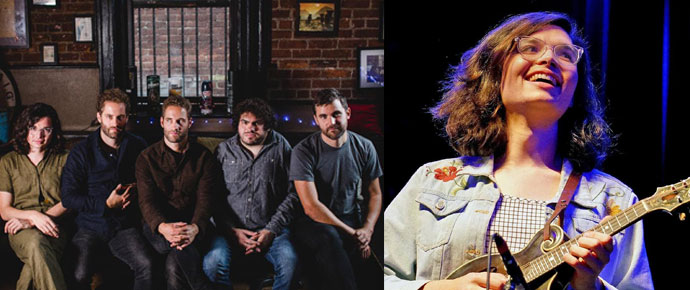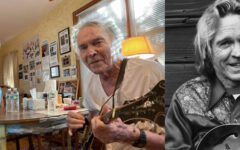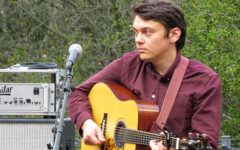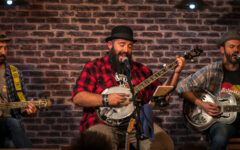
Maddie Witler is mandolin player and vocalist in the Boston-based Lonely Heartstring Band, which just released its third album, Smoke & Ashes. Maddie hails originally from La Crescenta, California. She picked up the mandolin when she was 14 and fell in love with the instrument, and bluegrass music. She’s studied with mandolinist Evan Marshall, with whom she worked her way through a lot of Bach, jazz, bluegrass, and other styles. Maddie attended the Berklee College of Music from 2010–2014, studying with musical heroes like John McGann, Joe Walsh, Julian Lage, Mike Compton, and Andy Statman. Maddie met her bandmates from the Lonely Heartstring Band while at Berklee, and has been a member since it began in 2012. The band will play the main stage at the California Bluegrass Association’s 2019 Father’s Day Festival, and Maddie will be an instructor at the CBA Music Camp the week before.
Hello Maddie. Thanks for your time. The Lonely Heartstring Band is on a roll. What’s on tap for the rest of 2019?
Hi! Thanks for having me. We’ve got a nice summer of festivals lined up with a little bit of touring on the West Coast and in New England. I’m looking forward to it!
Can you tell us about the players in LHSB?
George Clements is our lead singer and guitar player. I first met George in a Django Reinhardt ensemble class at Berklee in the fall of 2011. He’s a great musician and songwriter. I’m always impressed by his understanding of harmony, and it leads him to some great chord progression for our songs. He’ll also nail a set of solo James Taylor at a party every once in a while.
Charles Clements is our bass player and singer. I first met Charles in 2012 when he came to visit George. Charles has studied western classical music extensively, and subs with the Boston Symphony Orchestra from time to time. He’s a great songwriter and musician who is simultaneously informed by both his classical background and by pop and indie music. He’s got great time, and an eye for detail in music. In his free time he likes to study philosophy and consciousness. Ask him about the bicameral mind sometime.
Gabe Hirshfeld plays the banjo. I first met Gabe in a hallway as he waited to enter the classroom I was leaving in the fall of 2010. Gabe is a banjo player’s banjo player. He plays in a modern style and with a modern band, but he gets trad tone like Alan Munde. Gabe is one of the most melodic musicians I know. His solos and backup are filled with beautiful lines but you never forget it’s a banjo (in a good way). He’s quite a comedian and a great hang.
Patrick M’gonigle plays fiddle and sings. I first met Patrick in the spring of 2011. His house occasionally hosted music parties and that’s where I ended up. Patrick is a great and unique fiddle player. He has a great technical mastery of his instrument and has studied the great modern bluegrass players, but these days he mostly listens to and is heavily influenced by older players like Paul Warren and the playing on George Jones and Hank Williams records. Patrick was recently in Nashville recording interviews for season two of his bluegrass history podcast, the Breakdown. It’s an informative and interesting series and I’d encourage everyone to check it out!
I’m Maddie Witler and I play the mandolin.
Given the band’s name nod to the Beatles, I have to ask about the band’s influences in rock music and other genres.
We started as a Beatles bluegrass cover band that was hired for a wedding. We quickly discovered people liked that material and started booking gigs as “beatlegrass.” That was a bit constricting, so we came up with the Lonely Heartstring Band.
I wouldn’t say Smoke & Ashes is tradgrass, but it is certainly heartfelt and the instrumentation and vocals are top notch. How do you describe it?
Thank you. I very much agree that the album is not tradgrass. I would say that we’re a band with traditional bluegrass instrumentation that knows and loves bluegrass and is very influenced by it, but equally influenced by pop, folk, rock, and whatever else gets into our ears. I think to most people in the world we would be perceived as a bluegrass band. When describing the band I often say new acoustic, folkpop, and progressive bluegrass. We made an album of music we enjoyed playing and that represented us well, and you can call it whatever you like.
It has a darker feel. How is that different from the previous releases that were more driving?
The last record was a bit of a stylistic smorgasbord. We had songs that were more straight-ahead bluegrass, we had one tune with a swing feel, and we had some covers; we were just throwing everything out there to see what worked. For this record we had a clearer idea of what we wanted to sound like as a band. The record is all original, and the music is perhaps a bit more relevant to us as people than the last record.
In terms of the record being less or more “driving,” I do think this record has fewer faster tunes, and it really doesn’t have much that I would ever call “driving,” at least not in the colloquial bluegrass sense. At no point in the making of this record was there much worry of trying to keep things bluegrass, so we ended up with a lot of different grooves and textures. We mostly tried to be true to the character of each song, and I’m proud of the end result.
I’m curious what the favored harmony stack is and how it may differ from traditional bluegrass.
Usually if it’s three part it’ll be pretty much the classic bluegrass stack with George on lead, Charles on baritone, and Patrick on tenor, but we definitely don’t strictly stick to that.
Is there is a lot of duet harmonies?
On the new record there are a few moments of George and Charles singing classic lead and tenor duets. There are also several moments of the two of them singing in unison together for effect. We also have several songs, like our song, The Tide, where Patrick sings some duo harmonies with George. They’re a pretty versatile trio.
I hear a lot of your heroes in the solos, yet it’s uniquely your own sound. Whose style do you think comes most forward in your playing?
I’m not sure. The player I studied the most at one point was Chris Thile, but I don’t think my playing sounds like his. I mostly just try to fit my playing to the situation, so my influences come out in different ways at different times. John Hartford wisely said, “Style is based on limitation.” So I’m just trying to get some music out through the sieve of my limitations, the result being my style, whatever that may be.
What’s the key to getting such a clean sound at both slow and faster tempos?
You first have to get a clean sound at a slower tempo, and the key to getting a clean sound at a slower tempo – and eventually at any tempo – is really listening to yourself. Having a clear picture of the sound in your head and being able to objectively compare it to the sound you’re actually making. This is why recording yourself and listening back is such a good practice. It allows you to listen to yourself more objectively and to observe your own less conscious tendencies.
Who writes the material, and how do you work them into their final form?
For this record George, Charles, and Patrick were the ones bringing songs in various stages of completion to the band. Some songs were brought in pretty much done and then we just had to arrange them, and some were brought in with just the start of an idea for a section, and we worked the rest up together over time. The arranging process can be long, but I enjoy it. We basically take each section of each song and figure out what every instrument is doing and how it fits in to the whole. We’re mostly trying to strip away anything unnecessary from our parts until we end up with something that leaves space for everyone to play a meaningful role in the arrangement.
The songs seem more free-form and don’t follow the typical verse, chorus, solo patterns of most roots music.
I think that’s true for some of the songs, but most do follow a fairly standard combination of verse, chorus, and bridge. We make an effort to differentiate the feel of most song sections so two different verses might have very different things happening in the background, leading to the feeling of a less standard form. Also, we use solos sparingly. A little bit of solo can go a long way to support the song. We stretch out a bit and have a few more solos in live shows though.
Tell us about growing up in the Southern California scene.
It was a good scene to grow up in. I started on fiddle and met people at fiddle contests and Texas style jams, and I started to get into bluegrass through the bluegrass folks I met at those events. I got into the mandolin a bit, then the banjo when I was 12 or 13. I started going to jams around So Cal. My parents were great about taking me around to festivals. Some of the more memorable early bluegrass fests for me included Temecula Bluegrass Fest, Huck Finn, Topanga Banjo and Fiddle Contest, and Summergrass. I took lessons with a lot of folks important to the So Cal scene like Tom Sauber, Richard Green, Frank Javorsek, Bill Knopf, Ralph Barr, and Evan Marshall.
What So Cal bands did you follow growing up?
My parents and I went to see Sean and Sara Watkins with the Watkins Family Hour almost every week at Largo when it was still on Fairfax. Those shows were hugely influential to me. In terms of the local bluegrass scene, I used to see Loafer’s Glory with Tom and Patrick Sauber, Bill Bryson and Herb Pedersen, and various combinations of those players all the time. I saw the Witcher Brothers a few times. I used to see Phil Salazar around a lot. Most of my involvement in the scene was at jams and festivals.
Do you recall your first real performance?
The first time I ever performed anything really was playing a fiddle tune as part of my elementary school’s orchestra performance. The first time I ever got paid for playing was when I was 14, when I joined the Rainwater Bluegrass Band. We played at the Hollywood Farmer’s Market every Saturday and Sunday from 8:00 a.m. to 12:00 p.m. and got paid in tips. We also played some memorable party and event gigs around LA.
Do you have students and have you taught at camps before?
I have a few private students right now, mostly via Skype, and I’ve taught at camps a few times before. I love it! I was lucky enough to go to fiddle camps and bluegrass camps starting around age 10 or 11. I love the music camp environment. It’s one of my favorite ways to teach.
How do you approach teaching multiple students at a camp versus one-on-one instruction?
I move at a slightly slower pace with a group to make sure no one gets left too far behind, but for me that might be a good thing because I can tend to get excited when talking about music, bluegrass, and the mandolin.
Have you ever hit any major roadblocks to progressing and how did you navigate them?
I’ve had many roadblocks and I’ve either navigated or temporarily sidestepped them in many different ways. A lot of music and performing is a mental game of getting out of your own way and trusting yourself to do a good thing. I’ve learned a lot and I have much to learn.
I recall hearing you play an awesome banjo break somewhere. What instruments do you play?
Mandolin is the main thing. I also play a fair amount of guitar, banjo, and bass.
What brand and models of mandolin do you play?
I play a 1982 Gilchrist Model 5, #124. I’ve had it for two years and I love it.
What do you enjoy when not playing or teaching music?
Often practicing guitar, bass, or banjo, is the thing I’ll do to get away from the mandolin for a bit. Outside of music I like to cook, go to museums, go thrifting, collect records, see concerts, and generally lead a fairly normal existence.
Have you played CBA events previously?
I’ve played the Father’s Day Festival’s Vern Stage once with an early incarnation of the Get Down Boys. I also attended the festival once but wasn’t playing. I’m excited to finally be back!
You just moved from Boston to Brooklyn. I’m sure you’ve found the roots scene there already.
Yeah! I knew a lot of people and had a lot of friends here already, so it’s been a pretty easy shift to the NY scene. I’ve been playing some nice, very late, gigs here with some great players. There’s a lot to be inspired by.
What does the future hold for you?
Wow, you know I really have no idea. For me I just hope to make a living playing music and to play good music with good people. If I can manage that, things will be fine.
Do you have anything else you would you like to say?
I can be reached for Skype lessons at Maddiewitler@gmail.com.
Thanks Maddie. Looking forward to seeing you at the FDF and CBA camp.
Thanks for having me, Dave!
Notes
This is an update to the original interview in the California Bluegrass Association Breakdown monthly members publication.







